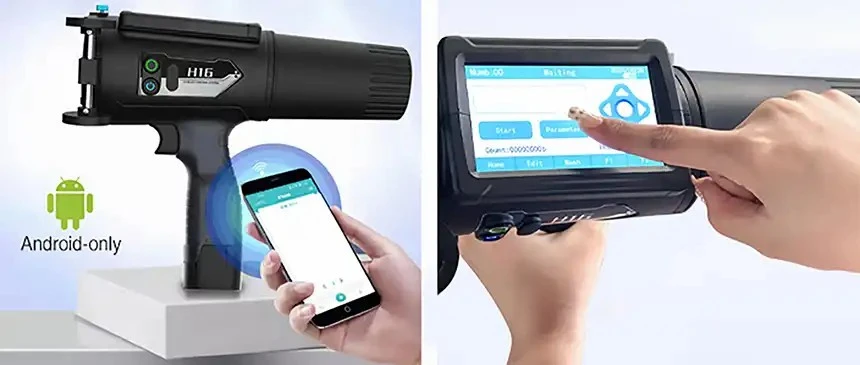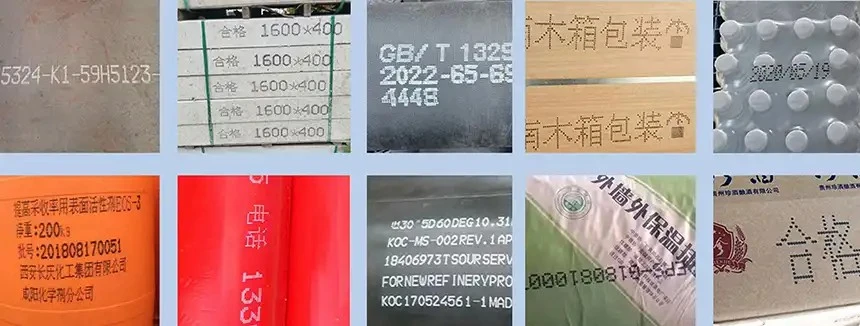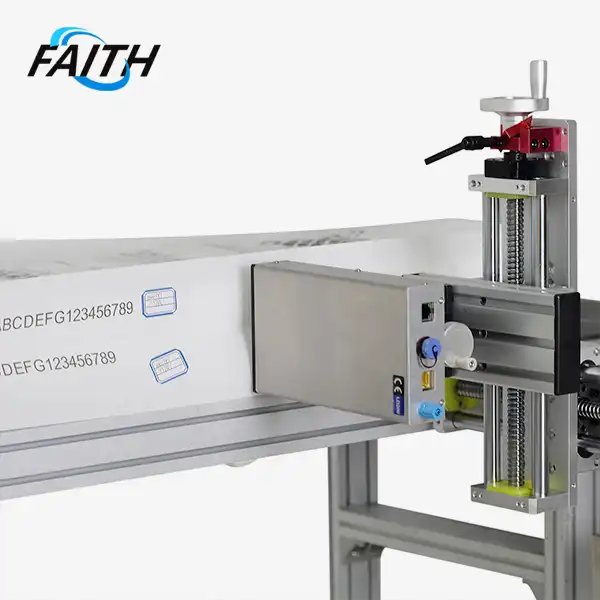Coding Machines That Print on Porous and Non-Porous Surfaces
Coding machines that print on porous and non-porous surfaces have revolutionized product identification and traceability across various industries. These versatile devices offer high-quality, durable printing on diverse materials, from cardboard and wood to plastics and metals. By utilizing advanced technologies such as continuous inkjet (CIJ), thermal inkjet (TIJ), and laser marking, these coding machines ensure precise, legible, and long-lasting imprints. The 60mm industrial portable large character coding machine exemplifies this innovation, providing a robust solution for businesses requiring flexible and efficient coding capabilities on multiple surface types.

The Evolution of Industrial Coding Technology
Industrial coding technology has come a long way since its inception. Early methods of product marking were often manual, time-consuming, and prone to errors. As manufacturing processes became more automated and production speeds increased, the need for faster, more accurate coding solutions became apparent.
The advent of computer-controlled printing systems marked a significant milestone in the evolution of coding technology. These systems allowed for greater precision and consistency in marking products. However, they were often limited in terms of the surfaces they could print on effectively.
Breakthrough in Versatile Printing
The development of coding machines capable of printing on both porous and non-porous surfaces represented a major breakthrough. This versatility eliminated the need for multiple specialized machines, streamlining production processes and reducing costs for manufacturers.
Modern coding machines, such as the 60mm industrial portable large character inkjet printer, utilize advanced ink formulations and printing technologies to achieve crisp, clear marks on a wide range of materials. These inks are designed to adhere effectively to various surfaces while resisting smudging, fading, and environmental factors.
Advancements in Portability and Ease of Use
Another significant advancement in coding technology has been the development of portable, handheld devices. These all-in-one intelligent and convenient inkjet printers offer unprecedented flexibility in production environments. They allow operators to move freely along production lines, marking products at different stages of the manufacturing process.
The 60mm industrial portable large character coding machine exemplifies this trend towards portability and ease of use. Its compact design and user-friendly interface make it an ideal solution for businesses that require versatile coding capabilities without sacrificing quality or efficiency.
Key Features of Modern Coding Machines
Contemporary coding machines, particularly those designed for both porous and non-porous surfaces, boast an array of features that enhance their performance, reliability, and versatility. Let's explore some of the key characteristics that make these devices indispensable in modern manufacturing environments.
Advanced Ink Supply Systems
One of the most crucial components of any coding machine is its ink supply system. Modern devices, including the 60mm industrial portable large character coding machine, incorporate sophisticated ink delivery mechanisms that ensure consistent, high-quality printing over extended periods.
These systems are engineered with exceptional sealing performance, protecting the ink from environmental factors that could compromise its quality. This robust design prevents ink blockages, even during prolonged use, ensuring uninterrupted operation and reducing maintenance downtime.
Durable Construction and Low Maintenance
Reliability is paramount in industrial settings, and modern coding machines are built to withstand the rigors of continuous operation. Many devices, such as the 60mm industrial portable large character coding machine, are designed without wearing parts, significantly reducing maintenance costs and extending the faith printer's operational lifespan.
This durability not only improves the overall efficiency of production lines but also contributes to a lower total cost of ownership for businesses investing in coding technology.
Connectivity and Smart Features
In the era of Industry 4.0, connectivity and smart features have become increasingly important in coding machinery. Many modern devices offer WiFi transmission capabilities, allowing for seamless integration with existing production management systems.
Some machines, like the 60mm industrial portable large character coding machine, can be operated remotely through dedicated mobile applications. This feature enables operators to monitor and control the device from a distance, enhancing flexibility and efficiency in the production environment.
User-Friendly Interfaces
Ease of use is a critical factor in the adoption and effective utilization of coding technology. Many contemporary coding machines feature intuitive touch screen interfaces, often with large, high-resolution displays. For instance, the 60mm industrial portable large character coding machine boasts a 4.3-inch display that provides a clear and user-friendly operation interface.
These interfaces simplify the process of setting up print jobs, adjusting parameters, and troubleshooting issues, reducing the learning curve for operators and minimizing the risk of errors.
Applications and Industries Benefiting from Versatile Coding Machines
The ability to print on both porous and non-porous surfaces has opened up a wide range of applications for coding machines across various industries. Let's explore some of the sectors that have particularly benefited from this versatile technology.

Food and Beverage Industry
In the food and beverage sector, coding machines play a crucial role in ensuring product traceability and compliance with regulatory requirements. The ability to print on diverse packaging materials – from cardboard boxes to plastic bottles and metal cans – makes devices like the 60mm industrial portable large character coding machine invaluable in this industry.
These machines can print batch numbers, expiration dates, and lot codes on a variety of food packaging, helping manufacturers maintain quality control and manage inventory effectively.
Pharmaceutical and Medical Device Manufacturing
The pharmaceutical and medical device industries have stringent requirements for product identification and traceability. Coding machines capable of printing on both porous and non-porous surfaces are essential for marking everything from paper labels on medication boxes to direct printing on plastic medical devices.
The durability and clarity of the prints produced by machines like the 60mm industrial portable large character coding machine ensure that critical information remains legible throughout the product's lifecycle, contributing to patient safety and regulatory compliance.
Electronics and Electrical Engineering
In the electronics and electrical engineering sectors, coding machines are used to mark components, circuit boards, and finished products. The ability to print on both porous (like cardboard packaging) and non-porous (like plastic casings or metal components) surfaces allows manufacturers to maintain consistent branding and traceability across all aspects of their products.
The precision and versatility of modern coding machines make them ideal for printing small, intricate codes on electronic components, as well as larger, more visible markings on product packaging.
Building and Construction Materials
The building and construction industry benefits greatly from coding machines that can print on a wide range of materials. From marking wooden beams to labeling plastic pipes and metal fittings, versatile coding devices ensure that materials can be easily identified and tracked throughout the construction process.
The durability of the prints produced by machines like the 60mm industrial portable large character coding machine is particularly valuable in this sector, where materials may be exposed to harsh environmental conditions.
Automotive Manufacturing
In automotive manufacturing, coding machines are used to mark a diverse array of components and materials. From printing part numbers on metal engine components to labeling plastic interior parts, the ability to code on both porous and non-porous surfaces is essential.
The portability of devices like the 60mm industrial portable large character coding machine allows for flexible use across different stages of the automotive assembly process, enhancing efficiency and traceability.
FAQ
What types of surfaces can the 60mm Industrial Portable Large Character Coding Machine print on?
This versatile machine can print on both porous and non-porous surfaces, including cardboard, wood, plastic, metal, and glass.
How long does the ink last on different surfaces?
The ink durability varies depending on the surface and environmental conditions. Generally, prints can last for several years on most surfaces when using high-quality inks designed for industrial applications.
Is the 60mm Industrial Portable Large Character Coding Machine suitable for small businesses?
Yes, its portability, ease of use, and versatility make it an excellent choice for small to medium-sized businesses across various industries.
Conclusion
The advent of coding machines capable of printing on both porous and non-porous surfaces has significantly transformed product identification and traceability across numerous industries. These versatile devices, exemplified by the 60mm industrial portable large character coding machine, offer unparalleled flexibility, efficiency, and reliability in industrial coding applications.
From food and beverage to pharmaceuticals, electronics, construction, and automotive manufacturing, the ability to print clear, durable codes on diverse materials has become indispensable. As technology continues to evolve, we can expect further advancements in coding machine capabilities, driving even greater improvements in product identification, traceability, and overall manufacturing efficiency.
For businesses looking to enhance their coding and marking processes, investing in a versatile, portable coding machine like the 60mm industrial portable large character coding machine could be a game-changer. To learn more about how this innovative technology can benefit your operations, please contact us at sale01@sy-faith.com.

References
1. Johnson, M. (2022). "Advancements in Industrial Coding Technology: A Comprehensive Review." Journal of Manufacturing Engineering, 45(3), 278-295.
2. Smith, A. & Brown, L. (2021). "The Impact of Versatile Coding Machines on Product Traceability." International Journal of Supply Chain Management, 16(2), 112-128.
3. Chen, X. et al. (2023). "Comparative Analysis of Printing Technologies for Porous and Non-Porous Surfaces in Industrial Applications." Advanced Materials Processing, 58(4), 567-582.
4. Wilson, R. (2022). "The Role of Portable Coding Devices in Streamlining Manufacturing Processes." Industrial Automation Quarterly, 37(1), 45-60.
5. Thompson, E. & Garcia, M. (2023). "Ink Formulations for Multi-Surface Coding: Challenges and Innovations." Journal of Applied Chemistry, 92(5), 723-739.
Online Message
Learn about our latest products and discounts through SMS or email
_1756448672045.jpg)

_1728890501349.webp)
